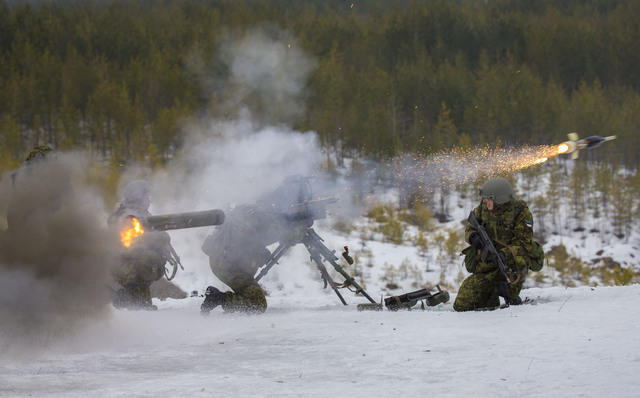
By Matthew Thomas in Security | April 22, 2020
At the beginning of this month, the U.S. delivered 128 javelin anti-tank missiles to Estonia, part of ongoing cooperation between the two countries. This will provide another moderate boost to the credibility of Estonia’s deterrent posture. These kinds of smaller procurements are an important part of the broader effort to build up a credible defense in case of Russian aggression and to signal that the risk outweighs the reward for attacking the Baltic States.
Yet, the numbers on this procurement highlight that while the region is perhaps best viewed as a single battle space, and while the three countries are stronger when they work together, each has different concerns based on individual characteristics. For Estonia, large scale tank warfare is not as reasonable a concern as it is for Lithuania. Here, geography plays a key role in determining how highly each state should prioritize anti-tank capabilities.
For Estonia, the primary concern for tank warfare will be along highways and in urban centers. Most likely this will be centered along the Narva-Rakvere-Tallinn route. But, in this environment, tanks will likely have less of an impact, as they are not well suited to fighting in built-up areas with limited space. Likewise, tanks are more vulnerable to anti-tank defenses in such environments. For Estonia, the forests, wetlands, and various hilly areas leave little open room for tanks to maneuver, pushing them to other areas where they will likely only play a supporting role.
 Source: CIA World Factbook 2011, created by Wikipedia user Radom1967 - Own work, CC BY-SA 4.0
Source: CIA World Factbook 2011, created by Wikipedia user Radom1967 - Own work, CC BY-SA 4.0
Though flatter, Latvia is just heavily forested as Estonia. For it, the primary concerns will be along highways, urban areas, and in the open fields of Zemgale. Parts of Latgale to the southeast may also be suitable for tank action. In Vidzeme, dense forests make the region unsuitable for tank warfare, and along the coast in the north, wetlands present an obstacle to tanks, pushing them to the road. This continues in Estonia, leaving tanks limited in their usefulness to the north. In February of 2018, Latvia signed a €108 million deal with EuroSpike for Spike anti-tank missiles. These missiles will also be installed on Latvia’s CVR(T) vehicles. For Latvia, the primary concern is to the south and southeast and along the Via Baltica highway to Rīga. But, unless an attack were launched in Latgale from within Belarus or Russia, Latvia’s chances of seeing tank warfare are largely dependent on Russian tanks’ success or failure in Lithuania.
For Lithuania, tank warfare is a very real and likely threat. Of the three Baltic countries, it has the longest ongoing cooperation with the United States on anti-tank missile procurements going back to 2002, and in February of last year, Lithuania purchased an additional $20 million in Javelin missiles. The country has far less forest cover compared with the other two, and is largely flat in the central lowlands. Open fields provide the kind of maneuverability that tanks need to be effective. But, to the southeast, which would be the most likely approach for Russian tanks, the hills around Vilnius favor defense. Thus, NATO needs to be prepared in order to prevent the Russians from getting past these hills to the lowlands around Kaunas. At Kaunas, logistics overland via the Suwałki Gap could be cut off and the Russians could connect their supply lines to Kaliningrad.
Russia maintains numerical superiority in tanks compared to NATO. Furthermore, Russian tanks are lighter weight than British or American tanks. For the Russians, tank divisions are a key strength, and as such will be used in the Baltic theater in the event of war, even though the theater as a whole is not well suited for them. Thus, they will likely seek to leverage that strength where it is most useful in Lithuania. For NATO and each of the three Baltic states themselves, anti-tank missiles, be they Javelins, Spikes, or Carl Gustavs, are a critical leveling force against Russia. Indeed, anti-tank capabilities will be critical for maintaining an open supply line along the Via Baltica until NATO can get its own tanks into the theater. Even then, anti-tank missiles will be a crucial component of NATO’s countermeasures against Russian forces.
With all this in mind, the Baltics should strategize which procurements should be made jointly, and which should be based on individual circumstances. The military and political leadership need to be thinking critically about individual strengths and weaknesses, both in capabilities and in geography. Procurements should be tailored to strategy, and should not be done without considering the forces, factors, and drivers within individual countries alongside the region as a whole. Here, intelligence and information sharing are also critical to developing a coherent strategy and defensive posture. In order to deter Russian attack, defensive abilities must be credible. In order for the Baltics to have more than just a “porcupine” defense, there needs to be more strategic and practical thinking from the top down. With this kind of coordinated effort, NATO could come in as defenders, rather than liberators. Without it, war will be much longer, and much more painful.
